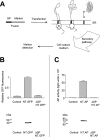The signal peptide of the rat corticotropin-releasing factor receptor 1 promotes receptor expression but is not essential for establishing a functional receptor
- PMID: 15901239
- PMCID: PMC1198925
- DOI: 10.1042/BJ20050113
The signal peptide of the rat corticotropin-releasing factor receptor 1 promotes receptor expression but is not essential for establishing a functional receptor
Abstract
Approximately 5-10% of the GPCRs (G-protein-coupled receptors) contain N-terminal signal peptides that are cleaved off during receptor insertion into the ER (endoplasmic reticulum) membrane by the signal peptidases of the ER. The reason as to why only a subset of GPCRs requires these additional signal peptides is not known. We have recently shown that the signal peptide of the human ET(B)-R (endothelin B receptor) does not influence receptor expression but is necessary for the translocation of the receptor's N-tail across the ER membrane and thus for the establishment of a functional receptor [Köchl, Alken, Rutz, Krause, Oksche, Rosenthal and Schülein (2002) J. Biol. Chem. 277, 16131-16138]. In the present study, we show that the signal peptide of the rat CRF-R1 (corticotropin-releasing factor receptor 1) has a different function: a mutant of the CRF-R1 lacking the signal peptide was functional and displayed wild-type properties with respect to ligand binding and activation of adenylate cyclase. However, immunoblot analysis and confocal laser scanning microscopy revealed that the mutant receptor was expressed at 10-fold lower levels than the wild-type receptor. Northern-blot and in vitro transcription translation analyses precluded the possibility that the reduced receptor expression is due to decreased transcription or translation levels. Thus the signal peptide of the CRF-R1 promotes an early step of receptor biogenesis, such as targeting of the nascent chain to the ER membrane and/or the gating of the protein-conducting translocon of the ER membrane.
Figures







Similar articles
-
The Pseudo signal peptide of the corticotropin-releasing factor receptor type 2A prevents receptor oligomerization.J Biol Chem. 2012 Aug 3;287(32):27265-74. doi: 10.1074/jbc.M112.360594. Epub 2012 Jun 11. J Biol Chem. 2012. PMID: 22689579 Free PMC article.
-
Functional Significance of the Signal Peptides of Corticotropin-Releasing Factor Receptors.Curr Mol Pharmacol. 2017;10(4):311-317. doi: 10.2174/1874467210666170224094915. Curr Mol Pharmacol. 2017. PMID: 28240192 Review.
-
The pseudo signal peptide of the corticotropin-releasing factor receptor type 2a decreases receptor expression and prevents Gi-mediated inhibition of adenylyl cyclase activity.J Biol Chem. 2010 Oct 22;285(43):32878-32887. doi: 10.1074/jbc.M110.129627. Epub 2010 Aug 3. J Biol Chem. 2010. PMID: 20682782 Free PMC article.
-
Structure and function of the ovine type 1 corticotropin releasing factor receptor (CRF1) and a carboxyl-terminal variant.Mol Cell Endocrinol. 1998 Sep 25;144(1-2):21-35. doi: 10.1016/s0303-7207(98)00157-9. Mol Cell Endocrinol. 1998. PMID: 9863624
-
Functional significance of cleavable signal peptides of G protein-coupled receptors.Eur J Cell Biol. 2012 Apr;91(4):294-9. doi: 10.1016/j.ejcb.2011.02.006. Epub 2011 May 4. Eur J Cell Biol. 2012. PMID: 21543132 Review.
Cited by
-
Role of the signal peptide in the synthesis and processing of the glucagon-like peptide-1 receptor.Br J Pharmacol. 2010 Jan;159(1):237-51. doi: 10.1111/j.1476-5381.2009.00517.x. Epub 2009 Nov 27. Br J Pharmacol. 2010. PMID: 20002095 Free PMC article.
-
The signal peptide of Staphylococcus aureus panton valentine leukocidin LukS component mediates increased adhesion to heparan sulfates.PLoS One. 2009;4(4):e5042. doi: 10.1371/journal.pone.0005042. Epub 2009 Apr 6. PLoS One. 2009. PMID: 19347045 Free PMC article.
-
Corticotropin-Releasing Factor Family: A Stress Hormone-Receptor System's Emerging Role in Mediating Sex-Specific Signaling.Cells. 2020 Mar 31;9(4):839. doi: 10.3390/cells9040839. Cells. 2020. PMID: 32244319 Free PMC article. Review.
-
The Pseudo signal peptide of the corticotropin-releasing factor receptor type 2A prevents receptor oligomerization.J Biol Chem. 2012 Aug 3;287(32):27265-74. doi: 10.1074/jbc.M112.360594. Epub 2012 Jun 11. J Biol Chem. 2012. PMID: 22689579 Free PMC article.
-
Use of a sequential high throughput screening assay to identify novel inhibitors of the eukaryotic SRP-Sec61 targeting/translocation pathway.PLoS One. 2018 Dec 13;13(12):e0208641. doi: 10.1371/journal.pone.0208641. eCollection 2018. PLoS One. 2018. PMID: 30543669 Free PMC article.
References
-
- Wallin E., von Heijne G. Properties of N-terminal tails in G protein-coupled receptors: a statistical study. Protein Eng. 1995;8:693–698. - PubMed
-
- Köchl R., Alken M., Rutz C., Krause G., Oksche A., Rosenthal W., Schülein R. The signal peptide of the G protein-coupled human endothelin B receptor is necessary for translocation of the N terminal tail across the endoplasmic reticulum membrane. J. Biol. Chem. 2002;277:16131–16138. - PubMed
-
- Rapoport T. A., Jungnickel B., Kutay U. Protein transport across the eukaryotic endoplasmic reticulum and bacterial inner membranes. Annu. Rev. Biochem. 1996;65:271–303. - PubMed
-
- Hegde R. S., Lingappa V. R. Regulation of protein biogenesis at the endoplasmic reticulum membrane. Trends Cell Biol. 1999;9:132–137. - PubMed
Publication types
MeSH terms
Substances
LinkOut - more resources
Full Text Sources

